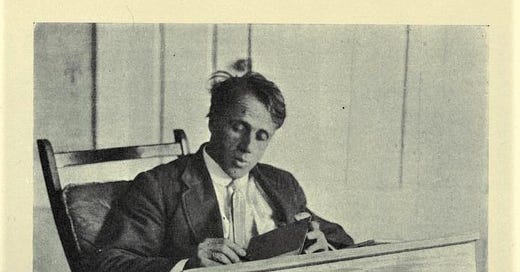For such a brief essay, Robert Frost’s “The Figure a Poem Makes” offers a wealth of insight into the nature, origins, and practice of poetry. The first concerns its limitations. Frost says that any poem worthy of the name strives for a kind of originality of sound. Yet the modern poet writing in English quickly realizes that most of the devices for achieving originality have been exhausted: the “resources … of vowels, consonants, punctuation, syntax, words, sentences, metre are not enough.”
In other words, the building blocks of diction, syntax, and form alone can no longer guarantee original verse, if ever they did. Nevermind how skillfully the poet defends, updates, or abandons received forms—if he is still saying the same old things about death or daffodils that poets have always said, his poetry cannot be original in the Frostian sense.
We might be surprised to hear Frost acknowledge the limits of those formal qualities his poems so skillfully employ; however, his aim is not to discard form but to investigate how a modern poem might achieve a fresh figure. The key, for Frost, is its subject matter—also “tune” and “theme”—what the poem purports to be about. “Just as the first mystery was how a poem could have a tune in such a straightness as metre,” Frost writes, “so the second mystery is how a poem can have wildness and at the same time a subject that shall be fulfilled.”
He is attempting to thread a needle here. On the one hand, he hopes to avoid “poetry as merely one more art of having something to say,” what Professor Cairns has called “denotative” poetry, or poetry that fails to rise much above the level of description. On the other hand, Frost is also responding to the modern proclivity toward abstraction in art and poetry, which might be understood as wildness without subject or fulfillment. Exactly how a poem finds and fulfills its subject is the second great insight of the essay.
No, that a poem finds its subject is. Frost maintains that a truly wild poem discloses itself through the writing process; it cannot be foreknown. The poet does not approach the page with ready-made conclusions, which she then shoehorns into verse. Rather, the poem “begins in delight, it inclines to the impulse, it assumes direction with the first line laid down, it runs a course of lucky events, and ends in a clarification of life … a momentary stay against confusion.” This momentary stay against confusion Frost elsewhere calls “wisdom,” and wisdom is always hard-won.
Unlike “trick poems” that can only feign wisdom, the original poem “finds its own name as it goes and discovers the best waiting for it in some final phrase at once wise and sad—the happy-sad blend of the drinking song.” And that final phrase, that spark, must surprise the poet as much as the reader.
Obviously, a poem will need more than “vowels, consonants, punctuation, syntax, words, sentences, and metre” to attain wisdom, though not less. Frost does not tell us how to get there, because he cannot. Yet twice in the essay he gestures toward the analogy of love: “The figure is the same as for love.”
Love, too, begins in delight and tends, we hope, toward wisdom. The deep affection and mutual understanding of an elderly couple, married fifty years, simply cannot be foreknown by the young couple at the altar; it must be discovered. Furthermore, how love flourishes or languishes along its course often evades explanation. Love, like wisdom, like a good poem, is mysterious, surprising.
Still, how does a poem find its way without a clear destination in view? The clue, for Frost, involves attending to our influences as we write, drawing on what we have learned “in and out of books.” Unlike scholars and scientists, who acquire knowledge through “conscientious thoroughness along projected lines of logic,” artists catch insights, ideas, and delights the way burrs are picked up by one’s socks while walking a field, “cavalierly.”
This assortment of odds-and-ends Frost calls knowledge. It is the wellspring of inspiration that gets a poem off the ground to find its wings and soar someplace new. “Read it a hundred times:” Frost concludes, “it will forever keep its freshness as a metal keeps its fragrance. It can never lose its sense of a meaning that once unfolded by surprise as it went.”
A century later, Ezra Pound’s injunction to make it new can burden the modern imagination. Haven’t we pretty much tried everything at this point?
I welcome Frost’s reminder that original work relies on outside influences and will inevitably bear the marks of its origins. “The artist must value himself as he snatches a thing from some previous order in time and space into a new order with not so much as a ligature clinging to it of the old place where it was organic.” We are always working with borrowed materials, burrs, flowers, branches picked up in someone else’s field. Our task is to graft them into our time.




